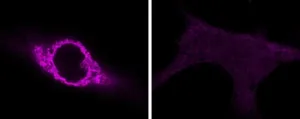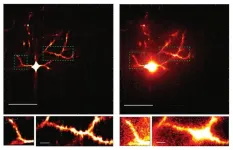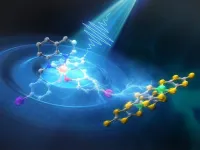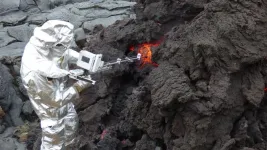(Press-News.org) TREX1 is a gene that is supposed to direct the maintenance of the entire body’s DNA, but new research shows that when people are born with mutated TREX1, it causes catastrophic damage to the DNA over time, resulting in a deadly rare disease called retinal vasculopathy with cerebral leukoencephalopathy (RVCL). Published in Nature Communications, the research was led by teams at the Perelman School of Medicine at the University of Pennsylvania and the Brain Research Institute at Niigata University in Japan.
While it was already known that a mutation in TREX1 was behind RVCL, the mechanism by which it did its damage was not known. In discovering that TREX1 speeds up the typical process of DNA damage—a process some theorize is tied to every animal’s aging process—the researchers may not have only discovered the weapon TREX1 uses on RVCL patients, but also offered insight beyond this rare disease population.
“It seems that accelerated DNA damage in RVCL causes the premature aging of certain cells, including the cells in the blood vessel wall,” said the study’s lead author Jonathan Miner, MD, PhD, an associate professor of Rheumatology at the Perelman School of Medicine. “If this is the case, then targeting TREX1 could have very broad implications for the treatment of many human diseases linked to aging, including cardiovascular diseases, autoimmune disorders, and cancer.”
RVCL impacts about 200 people worldwide and is often misdiagnosed as lupus, multiple sclerosis, or cancer. The disease causes the breakdown of small blood vessels in the body, which can affect many organs, including the brain, eyes, kidneys, liver, and bones. Patients with the condition typically do not begin to have symptoms—such as memory loss, partial loss of vision, and small strokes—until their 40s or 50s. Eventually, the breakdowns can cause organ damage and failure, including brain atrophy and blindness. There is no cure or treatment, and many patients die within five to ten years of symptoms beginning.
“We’re hopeful that our work will put us on the path toward improving the lives of patients with RVCL,” said the other lead author of this study Taisuke Kato, PhD, an associate professor of Molecular Neuroscience at Niigata University. “With our discoveries, we feel we will be much better equipped to address what is happening within their bodies.”
Studying RVCL models in animal and human cells, Miner and his colleagues explored their hypothesis that the TREX1 mutation, which shortens the gene, was causing instability within cells and damage that appears similar to breakdowns seen in radiation injuries.
They found that the mutation was interfering with a DNA repair process , which occurs when there is a break in both strands of DNA. This interruption of the process allowed DNA to be deleted, and cells prematurely aged and stopped dividing, which leads to overall premature aging and organ damage.
In addition to uncovering RVCL’s primary mechanism of damage, the researchers also found that the TREX1 mutation also displayed a cell-level vulnerability that mirrors those seen in people with mutations to the BRCA1 and BRCA2 genes, which cause breast cancer. Sure enough, the authors found similar elevated rates of risk of breast cancer in patients with TREX1 mutations as in patients with mutations in the BRCA1 and BRCA2 genes.
But on top of that, the TREX1 mutation’s effect on DNA damage also makes people with it more susceptible to damage from chemotherapy, the team found.
“I do worry that certain treatments may have accelerated the progression of disease in some patients,” Miner said. “In many cases, chemotherapy was prescribed as a way of treating suspected ‘autoimmunity’ since certain chemotherapeutic agents can also be used to treat patients with systemic lupus. This was frequently employed in the treatment of RVCL in the past, and even recently by some, and we are concerned that this would actually make the disease worse.”
The study’s findings provide a clearer picture for the types of treatments and medicines that could be pursued for people with RVCL. They could involve lowering levels of TREX1 in the body, correcting the mutation, or just blocking the gene’s DNA-damaging effects.
“Until those therapies are developed, we are working to figure out whether certain mediations already FDA-approved for the treatment of other diseases might be repurposed for RVCL or potentially impact TREX1 levels in the body overall,” Miner said. “TREX1 levels increase with age in multiple tissues in all humans—even in healthy individuals without RVCL—and we need to understand the processes linked to this.”
To that end, the study’s findings extend well beyond the population of patients with RVCL because of what it may add to the DNA damage theory of aging.
“One hope is that understanding the role of TREX1 in RVCL might help us uncover mechanisms that could link the TREX1 gene to a wide variety of human conditions that could also include normal aging,” Miner said.
This study was funded by the National Institutes of Health (K08AR070918, R01AI143982, R01NS131480, T32 GM007170), the Rheumatology Research Foundation, the Colton Center for Autoimmunity, the Clayco Foundation, the Penn RVCL Sisters Fund, the Japan Agency for Medical Research and Development (22ek0109424h0003), the Japan Society for the Promotion of Science (22H00466), and the Japan MHLW for Research on Intractable Disease (JP21FC1007).
END
Rare disease’s DNA-damaging mutation could have consequences for more common conditions
2024-06-04
ELSE PRESS RELEASES FROM THIS DATE:
Exploring three frontiers in marine biomass and blue carbon capture
2024-06-04
A new study offers first-time insights into three emerging climate innovations to safeguard or increase the carbon naturally captured by ocean and coastal ecosystems: rapid interventions to save the Great Barrier Reef, satellite-tracked kelp beds in the deep ocean, and seagrass nurseries in the United Kingdom. The research, published in Environmental Science & Policy and co-authored by leading climate scholars at Boston University, Aarhus University, and the University of Sussex Business School, advances knowledge of understudied interventions in marine ...
Microscope system sharpens scientists’ view of neural circuit connections
2024-06-04
The brain’s ability to learn comes from “plasticity,” in which neurons constantly edit and remodel the tiny connections called synapses that they make with other neurons to form circuits. To study plasticity, neuroscientists seek to track it at high resolution across whole cells, but plasticity doesn’t wait for slow microscopes to keep pace and brain tissue is notorious for scattering light and making images fuzzy. In a paper in Scientific Reports, a collaboration of MIT engineers and neuroscientists describes a new microscopy system designed for fast, clear, and frequent imaging of the living brain.
The system, ...
VHIO researchers demonstrate the utility of high-sensitivity liquid biopsy to predict and monitor response to immunotherapy
2024-06-04
The liquid biopsy technique applied in this work is based on the sequencing of the entire tumor genome from 138 patients and the monitoring of mutations in the blood. This approach achieves high sensitivity in detecting the tumor signal in the blood (1/1,000,000 DNA molecules), and the patterns found reflect how patients respond to immunotherapy.
This study is part of the Comprehensive Program of Cancer Immunotherapy and Immunology (CAIMI) at VHIO, funded by the BBVA Foundation, and is co-led by Dr Rodrigo Toledo, head of the Biomarkers and Clonal Dynamics Group at the Vall d’Hebron Institute of Oncology (VHIO), ...
Muscle disorder caused by key protein mutations uncovered in new study
2024-06-04
A recent study has found that the SMCHD1 protein plays a key role in controlling how genes are processed, which affects the progression of Facioscapulohumeral Muscular Dystrophy (FSHD). This discovery about SMCHD1's function in gene regulation is important because it opens new possibilities for developing targeted therapeutic strategies to combat the disease. By understanding more about how SMCHD1 works, scientists can explore new ways to fight the disease.
A recent study by MD-PhD student Eden Engal under the guidance of Dr. Yotam Drier and ...
Observing ultrafast photoinduced dynamics in a halogen-bonded supramolecular system
2024-06-04
Researchers uncover how the halogen bond can be exploited to direct sequential dynamics in the multi-functional crystals, offering crucial insights for developing ultrafast-response times for multilevel optical storage.
Halogen bonds are intermolecular interactions that arise from the attraction between a halogen atom (group 17 elements in the periodic table) and another atom with lone pairs, more generally a molecular entity with high electron density. Understanding the distinctive and highly directional nature of halogen bonds is crucial for crystal engineering and studying ...
USPSTF recommendation statement on interventions to prevent falls in community-dwelling older adults
2024-06-04
Bottom Line: The U.S. Preventive Services Task Force (USPSTF) recommends exercise interventions to prevent falls in community-dwelling adults 65 years or older who are at increased risk for falls. The USPSTF recommends that clinicians individualize the decision to offer multifactorial interventions to prevent falls to community-dwelling adults 65 years or older who are at increased risk for falls. Existing evidence indicates that the overall net benefit of routinely offering multifactorial interventions to prevent falls is small. When determining ...
ASCO: Proton therapy demonstrates advantages in Phase III head and neck cancer trial
2024-06-04
ABSTRACT 6006
CHICAGO ― According to preliminary data from a multi-institution Phase III trial led by researchers at The University of Texas MD Anderson Cancer Center, intensity modulated proton therapy (IMPT) achieved similar clinical outcomes and offered significant patient benefits when compared to traditional intensity modulated radiation therapy (IMRT) as part of chemoradiation treatment for patients with oropharyngeal (head and neck) cancer.
The results were presented today at the 2024 American Society of Clinical Oncology (ASCO) Annual Meeting by Steven Frank, M.D., professor of Radiation Oncology and executive director of the Particle ...
Mapping lava flows with groundbreaking field instrument
2024-06-04
WASHINGTON, June 4, 2024 – Millions of people live near active volcanoes that are constantly monitored for signs of an impending eruption. When one occurs, scientists and governments rely on data to estimate the extent of the possible damage, informing evacuation plans and disaster response efforts. The nature of eruptions, unfortunately, means collecting data about them can sometimes be as challenging as organizing a response.
In Review of Scientific Instruments, by AIP Publishing, researchers from the University at Buffalo developed a tool for measuring the viscosity of lava that could increase our understanding of molten rock as well as better improve ...
Access to prostate-specific antigen testing and mortality among men with prostate cancer
2024-06-04
About The Study: This population-based cohort study of men with prostate cancer suggests that higher county-level prevalence of prostate-specific antigen (PSA) screening was associated with lower odds of advanced disease, all-cause mortality, and prostate cancer–specific mortality. Associations varied by age, race and ethnicity, and U.S. Census region.
Corresponding Author: To contact the corresponding author, Hari S. Iyer, Sc.D., M.P.H., email hari.iyer@rutgers.edu.
To access the embargoed study: Visit ...
Service dogs for veterans and military members with posttraumatic stress disorder
2024-06-04
About The Study: This nonrandomized controlled trial found that compared with usual care alone, partnership with a trained psychiatric service dog was associated with lower posttraumatic stress disorder (PTSD) symptom severity and higher psychosocial functioning in veterans. Psychiatric service dogs may be an effective complementary intervention for military service–related PTSD.
Corresponding Author: To contact the corresponding author, Marguerite E. O’Haire, Ph.D., email maggieohaire@arizona.edu.
To access the embargoed study: Visit our For The Media website at this link https://media.jamanetwork.com/
(doi:10.1001/jamanetworkopen.2024.14686)
Editor’s ...





